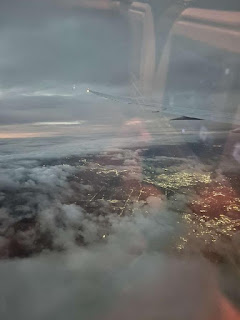We started our Saturday morning out right by heading to Tauranga for some farmers market shopping. The Tauranga Farmers Market was established 19 years ago and is an incorporated society. We enjoyed visiting with local venders and snacking on all the fun new treats. The farmer’s market was filled with fresh vegetables, baked goods, jams, honey, and kettle popcorn. The market is a great way for customers to buy products straight from the farmer and allows them to have conversations about what chemicals and methods have been utilized in the growth of products. After filling our bags with goods from the local market we made our way to the bus to travel around and check out the city.
 |
| Farmers
market in Tauranga. The
Farmers market showcased a variety of different products that range from fresh fruit
to packaged honey peanut butter. |
When driving through the city we drove right past the Port of Tauranga: Mount Maunganui Wharves which is the biggest export port in New Zealand.
 |
The biggest export port in New
Zealand. Pictured are numerous shipping containers used to
store goods that will be headed off to various places around the world. |
 |
| We enjoyed awesome
views from the Mount Maunganui South beach. |
The next stop on the tour schedule for us was down time at the Mount Maunganui South beach where we admired the various shells and enjoyed a little bit of sunshine, as well as waded through the water. The beach was very active with many people choosing to take advantage of the nice weather to surf and hike the trails along the beach.
 |
| SDSU
students walking along the factory floor in our bright colored vests. This is
the final step in the packaging process where they are moving the kiwi boxes to
be exported. |
We headed to the Mpac factory where we learned about packaging of kiwis. Mpac is the third largest kiwi packing plant in New Zealand. All kiwis grown in New Zealand are not allowed to be sold outside of the country unless the company has been granted permission to by the controlling agency. There are three types of kiwi fruit that are mainly sold and packaged there: yellow, green, and more recently red. The red kiwi fruit is in the first three years of commercialization and does not have as good of packaging life. If a kiwi does not fit the normal standard, then they are sold to dairy farmers to be used for their cattle. In the kiwi market, kiwis are not allowed to be sold at a discounted price. Katerina was the name of our tour guide of the facility. Her position in the company is grower services. She walked us through the process of packing the kiwi.
 |
| Kiwi
moving along the conveyer belt after being sorted. When on this belt the kiwi
are labeled with stickers. |
We started the tour by walking through the boxing station where robotic arms put together boxes and moved out finished packaged product. Then we were led to the floor below where we could see where a robotic arm used to stack the packaged fruit boxes into piles that were placed on a pallet. The other part of this floor was a complex series of conveyor belts that move the kiwis through the floor. These belts were used for sorting kiwi, adding stickers, and removing damaged fruit. When we finished our tour through the facility, we were gifted with a nice box of golden kiwi.
 |
| Green
kiwi fruit in the orchard in the Te Puke area. |
The next stop was the beautiful kiwifruit orchard in Te Puke area. We visited the family orchard to see how their kiwis are grown. The orchard is a small-scale orchard of 5 hectares of land with three of those hectares being golden kiwi plants and the other 2 hectares growing green kiwi. When at the farm we had a chance to learn about how the kiwi fruit are pollinated by 60 hives of bees that are contracted out to pollinate between the male and female kiwi plants. During our time at the kiwi farm, we had a chance to sample some golden kiwi. When the orchard first came into production, they only produced green kiwifruit. Recently the orchard transitioned to growing golden and green kiwi. The golden kiwi tends to be higher producing than the green kiwi and have a sweeter taste. They get a better return on golden kiwis than the green kiwis. The biggest factors that affect kiwi production would be climate and staffing. Climate is a big factor because certain climates can affect the growth of the kiwis. For example, when it hails kiwi producers could lose a lot of kiwis due to hail damage. The weather can be very harsh on the kiwi fruit and kiwi are a one crop of the year fruit. Staff is also a big factor because the orchard needs people to help tend to the kiwis. Production of kiwi can be very labor intensive so it can be very important for producers to have the right number of staff to assist with things like harvest, pruning, and pest maintenance.
Overall, we had a successful day learning about kiwifruit production and packaging. As well as sightseeing around Tauranga.









Comments
Post a Comment